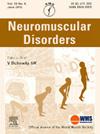274P Generation of cardiac organoids from DuchenneMuscularDystrophy patient-derived induced pluripotent stem cells: a novel approach to understanding cardiomyopathy
IF 2.7
4区 医学
Q2 CLINICAL NEUROLOGY
引用次数: 0
Abstract
Duchenne muscular dystrophy (DMD) is a progressive muscle disease caused by mutations in the dystrophin gene. Cardiomyopathy is the leading cause of death in DMD patients, but the exact mechanisms underlying it remain unclear. Due to the limitations of animal models, patient-derived human models need to be developed to investigate cardiac pathophysiological mechanisms better. Hence, 3D human cardiac organoids (hCOs) are designed to more closely resemble the structural and functional properties of the human heart than traditional 2D cell cultures or animal models. For this purpose, we generated DMD patient-derived induced pluripotent stem cells (hiPSC) and corrected DMD mutation with CRISPR/Cas9 gene editing, establishing isogenic control lines. Healthy controls and CRISPR/Cas9 edited cells with introduced DMD gene exon 50 deletion were also sources for these cell types. Under specified culture conditions, these stem cells differentiate into various cardiac cell types, including cardiomyocytes (CM), endothelial cells (EC), and cardiac fibroblasts (CF). We affirmed the presence of specific markers (troponin T for CM, DDR2 for CF, and CD31 and VE-cadherin for EC), indicating successful differentiation. Self-aggregation of CM, CF, and EC at controlled ratios (CM: 75%, CF: 15%, EC: 15%) resulted in the formation of 3D cardiac organoids. Overall, we successfully generated cardiac organoids from hiPSCs derived from DMD patients, healthy donors, and isogenic control samples, which will be used to understand the mechanisms of DMD cardiomyopathy further. Grants support: National Science Centre: MAESTRO 2018/30/A/NZ3/00412.
274P 从杜氏肌营养不良症患者衍生的诱导多能干细胞中生成心脏器官组织:了解心肌病的新方法
杜兴氏肌营养不良症(DMD)是一种由肌营养不良蛋白基因突变引起的进行性肌肉疾病。心肌病是导致 DMD 患者死亡的主要原因,但其确切机制仍不清楚。由于动物模型的局限性,需要开发源自患者的人体模型,以更好地研究心脏病理生理机制。因此,与传统的二维细胞培养或动物模型相比,三维人体心脏器官组织(hCOs)的设计更接近于人体心脏的结构和功能特性。为此,我们生成了来源于 DMD 患者的诱导多能干细胞(hiPSC),并通过 CRISPR/Cas9 基因编辑纠正了 DMD 基因突变,建立了同源对照品系。健康对照组和引入 DMD 基因外显子 50 缺失的 CRISPR/Cas9 编辑细胞也是这些细胞类型的来源。在特定的培养条件下,这些干细胞分化成各种心脏细胞类型,包括心肌细胞(CM)、内皮细胞(EC)和心脏成纤维细胞(CF)。我们确认了特定标记的存在(CM为肌钙蛋白T,CF为DDR2,EC为CD31和VE-cadherin),表明分化成功。CM、CF和EC以可控比例(CM:75%;CF:15%;EC:15%)自聚集形成了三维心脏器官组织。总之,我们成功地从来自 DMD 患者、健康供体和同源对照样本的 hiPSCs 中生成了心脏器官组织,这将用于进一步了解 DMD 心肌病的发病机制。资助:国家科学中心:MAESTRO 2018/30/A/NZ3/00412。
本文章由计算机程序翻译,如有差异,请以英文原文为准。
求助全文
约1分钟内获得全文
求助全文
来源期刊

Neuromuscular Disorders
医学-临床神经学
CiteScore
4.60
自引率
3.60%
发文量
543
审稿时长
53 days
期刊介绍:
This international, multidisciplinary journal covers all aspects of neuromuscular disorders in childhood and adult life (including the muscular dystrophies, spinal muscular atrophies, hereditary neuropathies, congenital myopathies, myasthenias, myotonic syndromes, metabolic myopathies and inflammatory myopathies).
The Editors welcome original articles from all areas of the field:
• Clinical aspects, such as new clinical entities, case studies of interest, treatment, management and rehabilitation (including biomechanics, orthotic design and surgery).
• Basic scientific studies of relevance to the clinical syndromes, including advances in the fields of molecular biology and genetics.
• Studies of animal models relevant to the human diseases.
The journal is aimed at a wide range of clinicians, pathologists, associated paramedical professionals and clinical and basic scientists with an interest in the study of neuromuscular disorders.
 求助内容:
求助内容: 应助结果提醒方式:
应助结果提醒方式:


